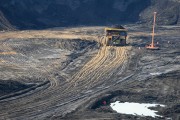Alberta Premier Ed Stelmach and Environment Minister Jim Prentice have crafted a new message, touting the oilsands as the safe alternative to offshore development in the wake of BP's oil spill. They're saying it loud and proud - that Alberta's oilsands are the responsibly developed, safe alternative to offshore development.
There's just one problem - what Prentice and Stelmach are advertising isn't available here in Alberta - and we hope the public won't be fooled by their clever bait and switch. My colleague, Karen Campbell, addresses the risks associated with the transport of fuel from the oilsands in her most recent op-ed, now I'll address the impacts and risks associated with oilsands development. It's time we debunk the latest talking points from the oilsands PR machine.
Oilsands production does NOT address U.S. security concerns
U.S. energy security will come from the energy independence available from accessing home-grown energy that doesn't come with the strings of high environmental impacts and risks attached.
Vice Admiral (Ret.) Dennis McGinn agrees, stating to a recent Senate Foreign Relations Committee, "...not just foreign oil - but all oil - and not just oil but all fossil fuels, pose significant security threats to military mission and the country."
The National Resources Defense Council further suggests "we gain energy security when we stop being dependent on oil. The best energy, climate and economic security is home-grown, clean energy."
Alberta does NOT impose mandatory greenhouse gas emissions reduction targets on large emitters.
Under Alberta's emissions regulations, oilsands operators need not reduce their emissions to comply. Instead, companies can pay $15 per tonne (amounting to 18 cents per barrel of oil) into a fund that to date has not yet proven actual reductions. Quite the opposite, in fact. While the province claims that since 2007 greenhouses gas emissions have been reduced by 17 million tonnes, according to Environment Canada's latest data, Alberta's greenhouse gas pollution actually rose by 43 per cent between 1990 and 2008, compared to 24 per cent for Canada as a whole. This means that Alberta, which contributed 18 per cent of Canada's GDP growth over this period, accounted for no less than 52 per cent of Canada's emission increase. 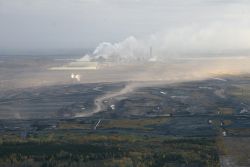
We're not the only ones who noticed the regulations are without teeth. Alberta Wildrose Alliance MLA Rob Anderson said the problem with the emissions fund is it doesn't change greenhouse-gas output. He went on to say, "It's a big show, but it's nothing more than a show."
The emissions aren't just adding to climate change. New research published in the prestigious Proceedings of the National Academies of Sciences shows the airborne chemicals from the oilsands industry are equivalent to a major oil spill every year.
Strict limits are NOT placed on industry's water use.
Stelmach has claimed there are strict limits on industry and that existing and approved projects may withdraw no more than three per cent of the average flow from the Athabasca River.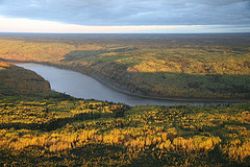
That's not the case. Rather than strict limits, industry is part of a voluntary agreement with government that is not enforceable. Two oilsands operators, Suncor and Syncrude, are exempt from this arrangement. Further, almost none of the water withdrawn from the Athabasca River is returned.
The Government of Alberta is NOT taking aggressive action on tailings.
Today, toxic tailings lakes cover 170 square kilometres - an area the size of the Vancouver, B.C. and big enough to completely cover U.S. cities such as Washington, D.C., Pittsburgh and Cleveland. Those liquid tailings are set to grow from 843 million cubic metres in 2010 to 1.1 billion cubic metres by 2020.
Not only are the tailings growing, they're also leaking. Industry and government have been reticen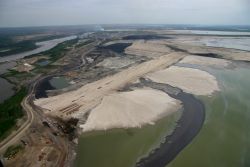 t to acknowledge the cumulative scale of the problem of leakage of tailings lakes, which an assessment of company filings shows could be on the order of 2.75 million gallons per day into groundwater.
t to acknowledge the cumulative scale of the problem of leakage of tailings lakes, which an assessment of company filings shows could be on the order of 2.75 million gallons per day into groundwater.
And while the Energy Resources Conservation Board (ERCB) set out tailings reductions rules for oilsands operators, it's not holding them liable for failing to meet the requirements.
Developers are NOT being held accountable to reclaim disturbed land to a state that is as productive as it was before it was developed.
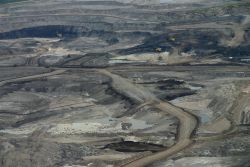 Of the 600 square kilometres of land disturbed by oilsands mining operations, only 1.04 square kilometres (0.2 per cent) is government certified as reclaimed. Calculations of financial securities to cover the cost of reclamation are not publicly available, inadequate and place Albertans and Canadians at risk of bearing the liability of costly clean up in the future.
Of the 600 square kilometres of land disturbed by oilsands mining operations, only 1.04 square kilometres (0.2 per cent) is government certified as reclaimed. Calculations of financial securities to cover the cost of reclamation are not publicly available, inadequate and place Albertans and Canadians at risk of bearing the liability of costly clean up in the future.
The government's job is NOT to spread misleading PR on the oilsands.
On Prentice's last trip to Washington three weeks ago, he said: "It's important that we as Albertans continue to go to Washington, that we as Canadians explain in the United States and elsewhere ... that we are developing the oilsands up to the highest possible environmental standards. We need to communicate that fact."
Stelmach chimed in on Friday too: "Perhaps we haven't explained them well enough, or wide enough. Our job is to get the message out."
Neither Prentice, nor Stelmach should be using their positions to sell the oilsands, rather, they should act as stewards to province's resources, ensuring responsible development of the oilsands and proper regulation of oilsands operators.
The oilsands are NOT the safer alternative to offshore drilling
The growing chorus claiming oilsands development is "environmentally friendly" is misplaced and ignores the fact that this source of energy has significant cumulative environmental impacts to the land, air and water and comes with considerable environmental risks such as a tailings breach.
Our "Waters that Bind Us: Transboundary Implications of Oilsands Development" report notes that should one of the pond walls (dykes) breach, an ecological disaster would occur. Dr. David Schindler, a highly respected water scientist, agrees and has said, "If any of those [tailings ponds] were ever to breach and discharge into the river, the world would forever forget about the Exxon Valdez."
The Gulf oil spill is not an opportunity to claim the oilsands are something they're not: safer, cleaner or more secure. The spill should serve as a grave reminder of what can happen if oil is not developed responsibly. Moreover, the spill should set in motion a cleaner, carbon-free energy future, where we don't depend on risky, environmentally damaging fossil fuels at all.




